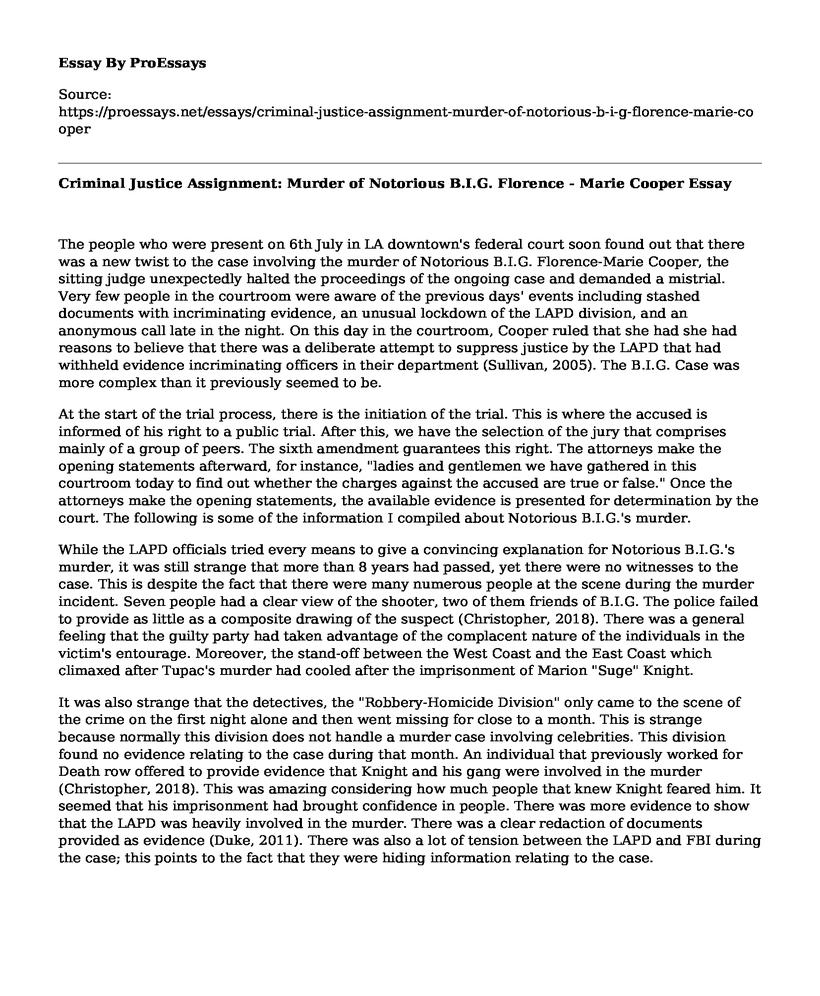The people who were present on 6th July in LA downtown's federal court soon found out that there was a new twist to the case involving the murder of Notorious B.I.G. Florence-Marie Cooper, the sitting judge unexpectedly halted the proceedings of the ongoing case and demanded a mistrial. Very few people in the courtroom were aware of the previous days' events including stashed documents with incriminating evidence, an unusual lockdown of the LAPD division, and an anonymous call late in the night. On this day in the courtroom, Cooper ruled that she had she had reasons to believe that there was a deliberate attempt to suppress justice by the LAPD that had withheld evidence incriminating officers in their department (Sullivan, 2005). The B.I.G. Case was more complex than it previously seemed to be.
At the start of the trial process, there is the initiation of the trial. This is where the accused is informed of his right to a public trial. After this, we have the selection of the jury that comprises mainly of a group of peers. The sixth amendment guarantees this right. The attorneys make the opening statements afterward, for instance, "ladies and gentlemen we have gathered in this courtroom today to find out whether the charges against the accused are true or false." Once the attorneys make the opening statements, the available evidence is presented for determination by the court. The following is some of the information I compiled about Notorious B.I.G.'s murder.
While the LAPD officials tried every means to give a convincing explanation for Notorious B.I.G.'s murder, it was still strange that more than 8 years had passed, yet there were no witnesses to the case. This is despite the fact that there were many numerous people at the scene during the murder incident. Seven people had a clear view of the shooter, two of them friends of B.I.G. The police failed to provide as little as a composite drawing of the suspect (Christopher, 2018). There was a general feeling that the guilty party had taken advantage of the complacent nature of the individuals in the victim's entourage. Moreover, the stand-off between the West Coast and the East Coast which climaxed after Tupac's murder had cooled after the imprisonment of Marion "Suge" Knight.
It was also strange that the detectives, the "Robbery-Homicide Division" only came to the scene of the crime on the first night alone and then went missing for close to a month. This is strange because normally this division does not handle a murder case involving celebrities. This division found no evidence relating to the case during that month. An individual that previously worked for Death row offered to provide evidence that Knight and his gang were involved in the murder (Christopher, 2018). This was amazing considering how much people that knew Knight feared him. It seemed that his imprisonment had brought confidence in people. There was more evidence to show that the LAPD was heavily involved in the murder. There was a clear redaction of documents provided as evidence (Duke, 2011). There was also a lot of tension between the LAPD and FBI during the case; this points to the fact that they were hiding information relating to the case.
Conclusion
The trial process ends with the closing statement from the attorneys. The lead attorney can state, "Ladies and gentlemen, you have all heard the facts of the case. The rest of it is left for the jury to make a determination. However, to everyone in the courtroom today, remember that nobody is above the law. At one point the law will catch up with those who try to circumvent justice."
References
Christopher (Biggie Smalls). (2018) Wallace Part 1 of 3: FBI Records: The Vault. Retrieved from https://vault.fbi.gov/Christopher%20%28Biggie%20Smalls%29%20Wallace%20/christopher-biggie-smalls-wallace-part-1-of-3/view
Christopher (Biggie Smalls). (2018). Wallace Part 2 of 3: FBI Records: The Vault. Retrieved from https://vault.fbi.gov/Christopher%20%28Biggie%20Smalls%29%20Wallace%20/christopher-biggie-smalls-wallace-part-3-of-3/view
Connecting the Dots. (2018). Frontline. Retrieved from http://www.pbs.org/wgbh/pages/frontline/shows/lapd/connect/noflash.html
Duke, A. (2011). FBI reveals documents in Biggie Smalls death probe. CNN.com. Retrieved from http://www.cnn.com/2011/CRIME/04/08/biggie.smalls.files/
Sullivan, R. (2005). The unsolved mystery of the notorious B.I.G. Rolling Stone 989, 124.
Cite this page
Criminal Justice Assignment: Murder of Notorious B.I.G. Florence - Marie Cooper. (2022, Jun 06). Retrieved from https://proessays.net/essays/criminal-justice-assignment-murder-of-notorious-b-i-g-florence-marie-cooper
If you are the original author of this essay and no longer wish to have it published on the ProEssays website, please click below to request its removal:
- Pop Art Impact to Guns, Violence, Civil Rights and Political Reforms
- Ethical and Moral Dilemma of a Defense Lawyer Essay
- Paper Example on Juvenile Sentencing
- Confirming Brett Kavanaugh to the Highest Court Paper Example
- Survey Research in Criminal Justice: Types, Advantages, and Disadvantages - Research Paper
- Essay Example on Community-Based Correction: Decarceration for Prison Overcrowding
- Facing the Pain of Violence and Crime: A Community Struggle - Essay Sample







